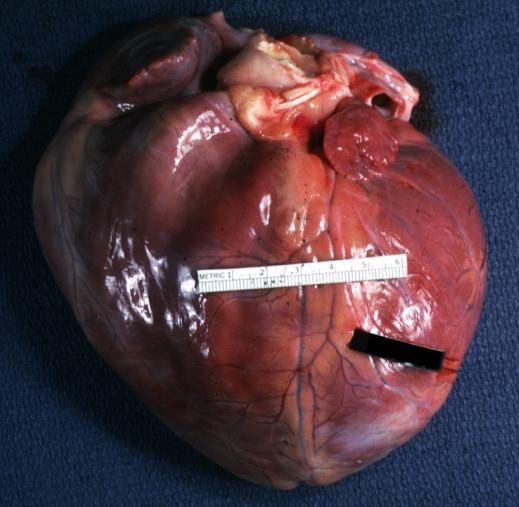Dilated cardiomyopathy pathophysiology
|
Dilated cardiomyopathy Microchapters |
|
Diagnosis |
|---|
|
Treatment |
|
Case Studies |
|
Dilated cardiomyopathy pathophysiology On the Web |
|
American Roentgen Ray Society Images of Dilated cardiomyopathy pathophysiology |
|
Risk calculators and risk factors for Dilated cardiomyopathy pathophysiology |
Editor-In-Chief: C. Michael Gibson, M.S., M.D. [1]; Associate Editor-in-Chief: Sachin Shah, M.D.
Jennifer Hall 21:56, 19 August 2013 (UTC)==Overview==21:56, 19 August 2013 (UTC)21:56, 19 August 2013 (UTC)~~ Cardiomyopathies are defined as a heterogeneous group of diseases of the heart associated with a mechanical and/or electrical dysfunction that usually (but not always) exhibit inappropropriate ventricular hypertrophy or dilation and are due to a variety of causes that frequently are genetic. [1] Phenotypic characteristics typically include ventricular chamber enlargement and systolic dysfunction with normal wall thickness.[1] Patients with dilated cardiomyopathy may experience a progressive decline in left ventricular contractile function, ventricular and supraventricular arrhythmias, conduction system problems, thromboembolism, sudden cardiac death and/or heart failure. [1]Dilated cardiomyopathy is the third most common cause of heart failure. [1]
Pathophysiology
Genetics
Our understanding of the role of genetics in dilated cardiomyopathy continues to grow. Inherited familial dilated cardiomyopathy has been associated with 50 mutations in genes encoding cytoskeletal, nucleoskeletal, mitochondrial and calcium handling proteins [2] These mutations are listed below.
*Genes Encoding Plasma Membrane Proteins
*Genes Encoding Cytoskeletal Proteins
- Actin, alpha, cardiac muscle 1, ACTC1
- Actinin, alpha 2, ACTN
- Ankyrin repeat domain 1, ANKRD1
- BCL2-associated athanogene 3, BAG3
- Cardiotropin, CTF1
- Cysteine and glycine-rich protein 3, CSRP3
- Desmin, DES
- [Desmocollin 2]], DSC2
- Desmoplakin, DSP
- DNAJ (Hsp40) homology, subfamily C, member 19, DNAJC19
- Dystrophin, DMD
- Eyes absent homology 4,EYA4
- Four and a half LIM domains 2, FHL2
- Fukutin, FKTN
- Lysosomal-associated membrane protein 2, LAMP2
- LIM domain binding 3, LDB3
- Myosin binding protein C, cardiac, MYBPC3
- Myosin, heavy chain 6, cardiac muscle, alpha, MYH6
- Myosin, heavy chain 6, cardiac muscle, alpha, MYH7
- Nexilin (F actin binding protein, NEXN
- Presenilin 1, PSEN1
- Presenilin 2, PSEN2
- RNA binding motif protein 20, RBM20
- Sarcoglycan alpha, SGCD
- Sodium channel, volatage-gated, type V, alpha subunit, SCN5A
- Tafazzin, TAZ
- Titin-cap, TCAP
- Thymopoietin, TMPO
- Troponin C type 1 (slow, TNNC1
- Troponin I type 3 (cardiac),TNNI3
- Troponin T type 2 (cardiac), TNNT2
- Tropomyosin 1 (alpha), TPM1
- Titin, TTN
- Vinculin, VCL
*Genes Encoding Calcium Handling Proteins
*Genes Encoding Mitochondrial Proteins
*Genes Encoding Nuclear Proteins
The roar of whole exome and whole genome sequencing technology has significantly increased the number of rare variants that are associated with dilated cardiomyopathy [2]. A challenge in the field today is that many individuals without disease carry rare variants in their genome. Thus the task at hand is not in the sequencing but rather in the translation to define if the rare variants discovered are in fact pathophysiologic in nature. Secondly, evidence is accumulating that many patients with dilated cardiomyopathy may have many different mutations that contribute to or modify disease. [3]
Associated Conditions
A review of systems is also helpful in regards to connective tissue disease associated dilated cardiomyopathy. Some of the disease that can be associated with dilated cardiomyopathy are:
- SLE (systemic lupus erythematosis)
- Rheumatoid arthritis
- Sarcoidosis
- Scleroderma
- Connective tissue diseases
- Pericardial effusion - It may accompany myocarditis but this finding is not specific.
Gross Pathology
Images shown below are Courtesy of Professor Peter Anderson DVM PhD and published with permission. © PEIR, University of Alabama at Birmingham, Department of Pathology
-
Cardiomyopathy: Gross excellent view of mitral valve from left atrium anterior leaflet appears to balloon a bit into the atrium
-
Cardiomyopathy: Gross excellent view of mitral and tricuspid valves from atria, appear normal anatomy.
-
Dilated Cardiomyopathy: Gross natural color close-up view of heart surgically removed for a transplantation shows aortic valve and anterior leaflet of mitral valve with cholesterol deposits endocardium of left ventricle is diffusely thickened
-
Cardiomyopathy: Gross external view of globular heart with patchy fibrosis seen through epicardium
-
Cardiomyopathy: Gross dilated left ventricle with marked endocardial thickening this is what has been called adult fibroelastosis
-
Dilated Cardiomyopathy: Gross good example huge dilated left ventricle
-
Dilated Cardiomyopathy: Gross dilated left ventricle with marked endocardial sclerosis (an excellent example)
-
Cardiomyopathy: Gross intact globular shaped heart
-
Dilated Cardiomyopathy: Gross opened left ventricle dilated with endocardial thickening good example
-
Cardiomyopathy: Gross globular heart external view 10 year old girl with sickle cell anemia
-
Cardiomyopathy: Gross horizontal sections of ventricles dilation type 10 year old girl with sickle cell anemia
-
Cardiomyopathy: Intermediate between hypertrophic and dilated
-
Dilated Cardiomyopathy: Gross opened globular left ventricle natural color (very good example)
-
Dilated Cardiomyopathy: Gross natural color external view globular heart 500 gm 24yo female seven pregnancies
References
- ↑ 1.0 1.1 1.2 1.3 Maron BJ, Towbin JA, Thiene G, Antzelevitch C, Corrado D, Arnett D; et al. (2006). "Contemporary definitions and classification of the cardiomyopathies: an American Heart Association Scientific Statement from the Council on Clinical Cardiology, Heart Failure and Transplantation Committee; Quality of Care and Outcomes Research and Functional Genomics and Translational Biology Interdisciplinary Working Groups; and Council on Epidemiology and Prevention". Circulation. 113 (14): 1807–16. doi:10.1161/CIRCULATIONAHA.106.174287. PMID 16567565.
- ↑ 2.0 2.1 McNally EM, Golbus JR, Puckelwartz MJ (2013). "Genetic mutations and mechanisms in dilated cardiomyopathy". J Clin Invest. 123 (1): 19–26. doi:10.1172/JCI62862. PMC 3533274. PMID 23281406.
- ↑ Golbus JR, Puckelwartz MJ, Fahrenbach JP, Dellefave-Castillo LM, Wolfgeher D, McNally EM (2012). "Population-based variation in cardiomyopathy genes". Circ Cardiovasc Genet. 5 (4): 391–9. doi:10.1161/CIRCGENETICS.112.962928. PMC 3495587. PMID 22763267.













